Why We Now Have A Frost-Free Fridge
In which things got icy
When we first moved to Bristol, we moved into an unfurnished flat that came supplied with white goods, partly because it made life much easier for us when moving. No worries about having to find a cooker, a washing machine or a fridge: but the downside was, we didn’t get to choose them.
When we moved in, the fridge was nice and clean and empty.
A few days later, though, we noticed that a bit of frost had started to build up on the back of the fridge. No problem, we thought. When we get chance, we’ll defrost it; it’s normal, after all, for fridges to get a bit of frost at the back.
A few weeks later, we noticed that a can of Kopparberg at the back of the fridge was looking rather iced-up too. We turned the fridge down (or is it up?) to its warmest setting, to give the ice a chance to melt away a bit. The fridge was still perfectly cold enough to keep everything, even on that setting. The Kopparberg, though, stayed icy. Indeed, it almost seemed as if the ice was still growing.
A few months later, I remembered I had some Kopparberg in the fridge. Except … it didn’t seem to be there any more. And there was, now, quite a lot of ice at the back. It seemed to have a shadow in it at one end.
Twenty-one months or so after we first switched the fridge on, we suddenly realised we were about to move out. So, we’d better switch the fridge off now, and maybe, just maybe, we might have a chance of defrosting it. We stuffed the bottom of the fridge with towels, turned the power off, and waited. Slowly, ever so slowly, the ice started to drip. The can of Kopparberg started to reappear; when I prised it out of its icy prison, and shook the tin, the ice inside it klunked against the edges. After about twelve hours of melting, I gave the block of ice a jolt. The whole thing, along with one of the fridge shelves, came free. I moved it to the sink.
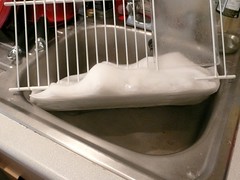
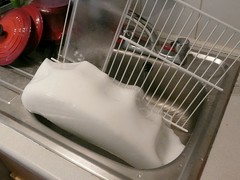
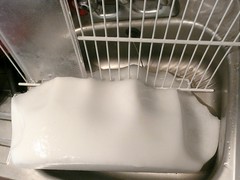
We hunted down a tape measure, and K measured it whilst I took photos:
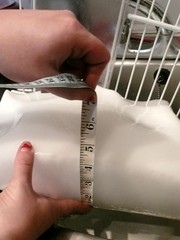
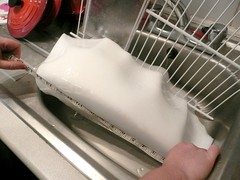
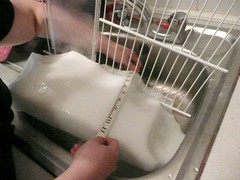
That’s about 4 inches deep, 14 wide and 11 tall. It’s not a cube, of course; on the other hand, it had already lost several inches in size. Overall, I think we must have had at least 6 or 7 litres of water stuck to the back of our fridge.
Moving to somewhere new, we had to buy ourselves a fridge, along with all the other kitchen equipment. As soon as we went shopping for one, we made a bee-line straight in the direction of the frost-free refrigeration section. I think, from the pictures, you can probably see why.

 Home
Home Newer posts »
Newer posts »